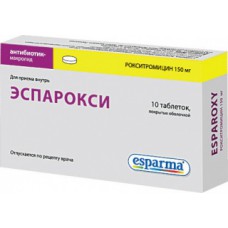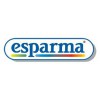Expiration date: 11/2026
The composition and form of issue:
Tablets, film-coated. 1 tablet contains active substance:
the roxithromycin 150 mg
excipients: corn starch — 88, 86 mg lactose monohydrate — 78, 43 mg of calcium hydrogen phosphate dihydrate and 30 mg of magnesium stearate — 9, 71 mg talc 5 mg silicon colloidal decoside — 11, 43 mg sodium glikolat — 6, 57 mg
shell: hypromellose 5 mg talc — 7, 14 mg of titanium dioxide — 1, 71 mg, macrogol 4000 — 2, 14 mg
in packing contour cell 10 PCs the paper cartons 1 or 2 packs.
Description pharmaceutical form:
White, round, biconvex, coated tablets.
Pharmacokinetics:
Absorption quick. Cmax in blood plasma after ingestion of 150 mg — 6, 6 mg/l, Tmax — 2, 2 h after intake of 300 mg — 9, 6 mg/l and 1 and 5 h, respectively. In children, Cmax in plasma (at a 2-fold reception 2, 5 mg/kg/day) — 8, 7-10, 1 mg/l and is reached after 2 h. Reception at intervals of 12 h maintains effective concentrations in the blood for 24 h. Css in plasma when taking 150 mg 2 times a day for 10 days is between 2 and 4 days and is 9, 3 mg/l at the dose of 300 mg 2 times a day for 11 days — 10, 9 mg/L.
It penetrates into the lungs (concentration — 5, 6-3, 7 mg/kg), Palatine tonsils (2, 6-1, 7 mg/kg) and prostate (2, 8-2, 4 mg/kg) inside cells, particularly neutrophils and monocytes, stimulates their faguoqitarnuyu activity. Practically does not penetrate through the GEB. The volume of distribution is 31, 2 l. Relationship to plasma proteins (mainly with an acidic glycoprotein to a lesser extent, to albumin and lipoproteins) — 96%, is saturable in nature and is reduced at concentrations above 4 mg/L.
Partially metabolized. T1/2 — 10, 5-14 h in children aged 1 month to 13 years — up to 20 h. it is Excreted mainly with feces (50% active substance), the remainder by the kidneys (10%), lung (15%). Less 0, 05% of the dose is excreted in breast milk.
In severe chronic renal failure T1/2 of 25 h and AUC is increased, reduced renal clearance. In elderly patients (60-79 years) increases the AUC and T1/2, decreases the renal clearance (decreased kidney function), but the amount secreted by the kidneys of the drug is not changed.
In patients with alcoholic cirrhosis of the liver T1/2 and Cmax in plasma are significantly increased.
Description pharmacological action:
Polusinteticeski antibiotic group macrolides for oral administration. Has bacteriostatic action: binding to 50S ribosome subunit, inhibits translocation reaction and transpeptidation, the process of formation of peptide bonds between amino acids and peptide chain inhibits protein synthesis by ribosomes, resulting in inhibits the growth and reproduction of bacteria.
In vitro sensitive to the drug: Streptococcus agalactiae, Streptococcus pneumoniae (Pneumococcus), Neisseria meningitidis (Meningococcus), Listeria monocytogenes, Mycoplasma pneumoniae, Chlamydia trachomatis, Ureaplasma urealyticum, Legionella pneumophila, Helicobacter pylori (Campylobacter), Gardnerella vaginalis, Bordetella pertussis, Moraxella catarrhalis (Branhamella catarrhalis), Haemophilus ducreyi.
The following micro-organisms showed variable sensitivity in vitro: beta-hemolytic Streptococcus group A (Streptococcus pyogenes), Staphylococcus aureus, Haemophilus influenzae, Staphylococcus epidermidis.
Indications:
- Infection easy and moderate severity caused by sensitive to the drug pathogens:
- lower respiratory tract acute bronchitis, pneumonia caused by Streptococcus pneumoniae, atypical pneumonia caused by Mycoplasma pneumoniae
- ENT — pharyngitis, tonsillitis, sinusitis, otitis media caused by beta-hemolytic Streptococcus group A and Streptococcus pneumoniae
- skin and soft tissue erysipelas, pyoderma, caused by Staphylococcus aureus and beta-hemolytic Streptococcus group A
- urinary tract infections — urethritis in men, caused by Chlamydia trachomatis ?Ureaplasma past.
Contraindications:
- hypersensitivity
- concomitant use of ergotamine, dihydroergotamine (risk of symptoms of "ergotism"), cisapride, pimozide. astemizole and terfenadine
- pregnancy
- lactation
- children up to 12 years and weighing at least 40 kg.
For dosage forms that contain lactose (advanced) — lactose intolerance.
With caution: hepatic failure (hepatic cirrhosis with jaundice and/or ascites), renal failure, advanced age, concomitant use with colchicine, dofaminomimetiki — ergot alkaloids (including bromocriptine, cabergoline, lisuride, ropinirol), cyclosporine, theophylline.
Side effects:
Nausea, vomiting, loss of appetite, change of taste and/or smell, pain in the epigastric region, diarrhea, increase in liver transaminases and alkaline phosphatase, cholestatic or hepatocellular acute hepatitis, pancreatitis, dizziness, headache, paresthesia, allergic reactions (bronchospasm, urticaria, rash, purpura, angioedema, anaphylactic shock), development of superinfection.
Drug interactions:
Increases the absorption of digoxin, increasing the risk of its toxic action (necessary monitoring of ECG and the concentration of digoxin in the blood plasma). Clinically significant interactions with warfarin have not been identified. It was reported about the increase of PV or MHO at simultaneous reception with antagonists of vitamin K, so during treatment should be monitored MHO.
Increases T1/2 and AUC of midazolam (amplification and increase of duration of action). Increases concentration in plasma theophylline, cyclosporine.
Increases serum concentrations of astemizole, cisapride, pimozida, that leads to a lengthening of the QT interval and/or severe arrhythmias (ECG monitoring).
Can displace disopyramide from plasma proteins, leading to an increase in its concentration in the serum (a control ECG and disopyramide concentrations in blood plasma).
Ergotamine and ergotaminopodobnykh vasoconstrictor drugs lead to the development of ergotism, necrosis of the extremities.
Method of application and dose:
Inside, adults — 150 mg 2 times a day, morning and evening, before meals or 300 mg once. The course of treatment is determined individually depending on the evidence, the seriousness of the infection process and activity of causative agent in infections caused by beta-haemolytic Streptococcus, treatment should be not less than 10 days. When liver failure — 150 mg 1 time per day.
Children and adolescents older than 12 years with body weight over 40 kg — as for adults.
Overdose:
Treatment: gastric lavage, symptomatic treatment, specific antidote exists.
Special instructions:
When liver failure during treatment should monitor liver function. With the development of superinfection or pseudomembranous colitis roxithromycin should be discontinued immediately and to appoint the corresponding therapy.
If the treatment lasts more than 14 days, you need to regularly monitor the liver and kidneys and blood picture.
The impact on the ability to participate in road traffic and to operate machines and mechanisms
Patients receiving the drug should refrain from potentially hazardous activities associated with the need to focus and increased speed of psychomotor reactions.


